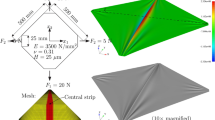Abstract
Analogical physical models are a preferred technique to intuitively grasp complex engineering problems. It is well-known that the equilibrium minimal-surface configuration of membranes under equibiaxial tension can be visually represented by the surface of a soap film under equivalent boundary conditions, but this analogy fails when the stress state is not uniform equibiaxial. We extend to this situation the analogy with soap films. The equilibrium state of an orthotropically tensioned membrane is found by geometrically stretching the shape of a soap film, in a precise manner depending upon the applied state of stress. The procedure is easily done by elaborating digital pictures. The method is mathematically justified under the kinematic hypotheses of small strains and large rotations, and further verified in a parametric design environment. It can also provide an insight into the equilibrium configuration of cable-nets, when the stresses in the warp and weft directions are considerably different. Furthermore, this visualization favors implementing transformable shapes for membranes or orthogonal cable nets, as a consequence of a modification of the ratio of the principal stress components.


















Similar content being viewed by others
References
Adriaenssens S, Block P, Veenendaal D, Williams C (eds) (2014) Shell structures for architecture. form finding and optimization. Routledge, London
Aish R (1992) Computer-aided design software to augment the creation of form. In: Penz F (ed) Computer in architecture. Longman, London
Barsotti R, Ligarò SS, Royer-Carfagni G (2001) The web bridge. Int J Solids Struct 38(48–49):8831–8850
Beatini V (2015a) Polar method to design foldable plate structures. J IASS 56(2):184, 125–136
Beatini V (2015b) Translational method for designing folded plate structures. Int J Space Struct 30(2):85–97
Beatini V, Korkmaz K (2013) A transformable tensile structure. In: Bogner-Balz H, Mollaert M, Pusat E (eds) Re-Thinking lightweight structures, Tensinet. Tensinet, Istanbul
Beatini V, Royer-Carfagni G (2016) Large transformations of tensile membrane structures with moderate strains. Math Mech Solids, published on line. doi: 10.1177/1081286516643360, in press
Beghini A, Beghini LL, Schultz J, Baker WF (2013) Rankine’s theorem for the design of cable structures. Struct Multidiscip Optimiz 48(5)
Bletzinger KU, Ramm E (1999) A general finite element approach to the form finding of tensile structures by the updated reference strategy. Int J Space Struct 14(2):131–145
Buchholdt HA (1999) An introduction to cable roof structures. Thomas Telford, London
Cai K (2011) A simple approach to find optimal topology of a continuum with tension-only or compression-only material. Struct Multidiscip Optim 43(6):827–835
Chen Y, You Z (2005) Mobile assemblies based on the Bennett linkage. Proc Royal Soc, Part A 461(2056):1229–1245
Feng R, Zhang LL, Wu Y, Shen S (2009) Dynamic performance of cable net facades. J Constr Steel Res 65(12):2217–2227
Fisco NR, Adeli H (2011) Smart structures. part I—active and semi-active control. Sci Iranica 26(1):275–284
Frazer JH (1995) An evolutionary architecture. Architectural association publications, London
Gantes C (2001) Deployable structures. analysis and design. WIT Press, Southampton
Guidon R (1990) Designing the design process. exploiting opportunistic thoughts. Hum Comput Interact 5:305–344
Hedgepeth JM (1982) Accuracy potentials for large space antenna reflectors with passive structure. J Spacecraft Rockets 19(3):211–217
Hilson B (1993) Basic structural behavior. understanding structures from models. Thomas Telford Ltd, London
Krish S (2011) A practical generative design method. Comput Aided Des 43(1):88–100
Lai CY, Pellegrino S (2001) Umbrella-type furlable reflector based on tension-truss concept. 42nd AIAA/ASME/ASCE/AHS/ASC structures, structural dynamics, and materials conf. and exhibit. American Institute of Aeronautics and Astronautics, Reston
Larena AB (2009) Shape design methods based on the optimisation of the structure. historical background and application to contemporary architecture. In: Kurrer KE, Lorenz W, Wetzk V (eds) Proceedings of the third international congress on construction history, Cottbus, May 2009. Neunplus1, Berlin
Logan B, Smithers T (1993) Creativity and design as exploration. In: Gero JS, Maher ML (eds) Modelling creativity and knowledge-based creative design. Erlbaum Associates, Lawrence, pp 139–175
Lynn G (1993) Folding in architecture. architectural design profile 102. Wiley, London
Menges A (2012) Material computation. higher integration in morphogenetic design. Wiley, London
Nerdinger W (2005) Frei Otto. complete works. Birkhäuser Architecture, Berlin
Preumont A (2011) Vibration control of active structures. an introduction. solid mechanics and its applications. Springer, Berlin
Rippmann M, Lachauer L, Block P (2012) Interactive vault design. Int J Space Struct 27(4):219–230
Royer-Carfagni G (1999) Wrinkled membranes and cable-stayed bridges. ASCE J Bridge Eng 4:56–62
Royer-Carfagni G (2003) Parametric-resonance-induced cable vibrations in network cable-stayed bridges. A continuum approach. J Sound Vibr 262(15):1191–1222
Salvadori MG, Tempe M (1983) Architecture and engineering. an illustrated teacher’s manual on why buildings stand up. Academy of Sciences, New York
Schittich et al (2013) Detail engineering 1. Schlaich Bergermann Und Partner. Birkhauser Verlag, Berlin
Schlaich J, Moschner T (2005) Prestressed cable-net facades. Struct Eng Int 15(1):36
Shea K, Aish R, Gourtovaia M (2005) Towards integrated performance-driven generative design tools. Autom Constr 14(2):253–264
Sheck HJ (1974) The force density method for form-finding and computation of general networks. Comput Methods Appl Mech Eng 3:115–134
Szalapaj P (2001) CAD principles for architectural design. Architectural press, Oxford
Tachi T (2010) Freeform rigid-foldable structure using bidirectionally flat-foldable planar quadrilateral mesh. In: Ceccato C et al (eds) Advances in architectural geometry. Springer, Vienna, pp 87–102
Tanaka H, Natori MC (2004) Shape control of space antennas consisting of cable networks. Acta Astronaut 55(3–9):519–527
Tibert AG, Pellegrino S (2002) Deployable tensegrity reflectors for small satellites. J Spacecraft Rockets 39(5):701–709
Wang Z, Li T, Cao Y (2013) Active shape adjustment of cable net structures with pzt actuators. Aerosp Sci Technol 26(1):160–168
Wang Z, Li T, Ma X (2014) Method for generating statically determinate cable net topology configurations of deployable mesh antennas. J Struct Eng 141(7):04014182
Acknowledgments
Partial support of the European Community under Contract RFSR-CT-2012-00026 (S+G RFS-PR-11017) is gratefully acknowledged.
Author information
Authors and Affiliations
Corresponding author
Rights and permissions
About this article
Cite this article
Beatini, V., Royer-Carfagni, G. Soap film analogy for anisotropically stretched membranes and cable nets. Struct Multidisc Optim 55, 885–898 (2017). https://doi.org/10.1007/s00158-016-1533-z
Received:
Revised:
Accepted:
Published:
Issue Date:
DOI: https://doi.org/10.1007/s00158-016-1533-z




